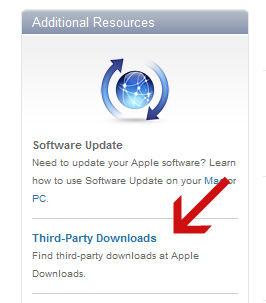Disappeared: Apple’s Mac Download page
May 10th, 2010Chris Foresman at Ars Technica:
A link to the Downloads page was also featured as one of the top navigation links on Apple’s website until a section for the iPad replaced it several weeks ago. Of course, the Downloads page has gone without updates for several days in a row in the past. The most recent month-long update drought, however, has many developers wondering if Apple plans to discontinue the Downloads page altogether.
I like the idea of a Mac “App Store Lite” – because that’s exactly how I thought of Apple’s Download page when I bought my first Macintosh in 2005. As a new subscriber to the Apple way of life, the Downloads page was an easily-browsable headquarters.
In fact, I still go there from time to time and browse through the apps. Most offer a free trial period, unlike the iTunes-based App Store, so there is little barrier to entry. Try an app. Don’t like it? Try another.
The Downloads page disappearing from the Apple title makes sense, given that the iPad is the new focus, and actually gives clarity to Apple’s lineup:
Here’s an older version of the nav bar, with the Downloads link:
Before that, we had iCards and QuickTime and all kinds of nonsense. To me, the Downloads page makes more sense under the Mac heading – since it’s all software for the Macintosh.
(And speaking of organization: I know that FileMaker is its own pseudo company thingy, with its own headquarters and software for both Mac and Windows, but really? Why not lump Bento in with iWork and have FileMaker serve as a pro app, like Aperture?)
The thing is, the Downloads page isn’t found in the Mac section. After digging, I found it on the Support Downloads page in a inconspicuous location:
Even worse: it’s nowhere to be found on the Site Map page. As Foresman points out in the Ars Technica article, the only easy way to get to the Downloads page is via the Apple menu in OS X:
The downloads page languishing and hidden in the remote corners of apple.com is not a good sign. It reminds me of what Apple’s doing to AppleTV.
What could it mean?
- That, just as Ars postulates, Apple could be moving to an App Store for the Mac
- That Apple has turned their attention away from the Mac, spelling doom and ruin
- Apple has been so busy with other things that…well…it just hasn’t gotten around to playing with the Downloads page
I’m not a fan of any of those options.






